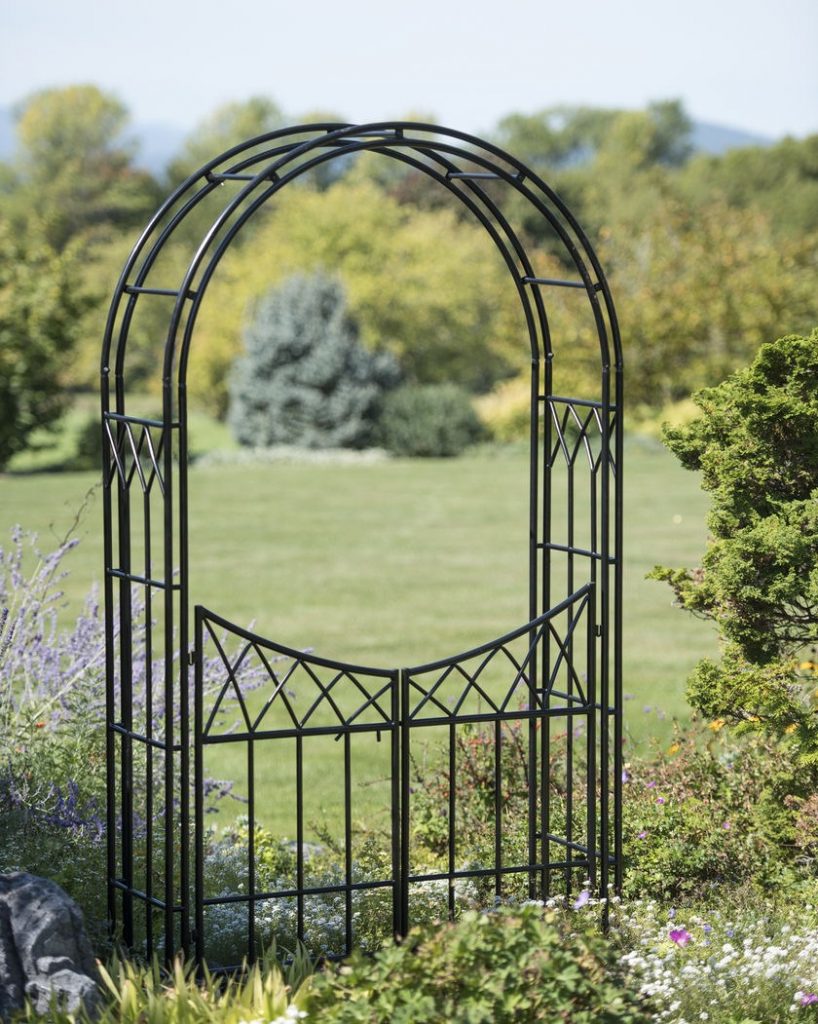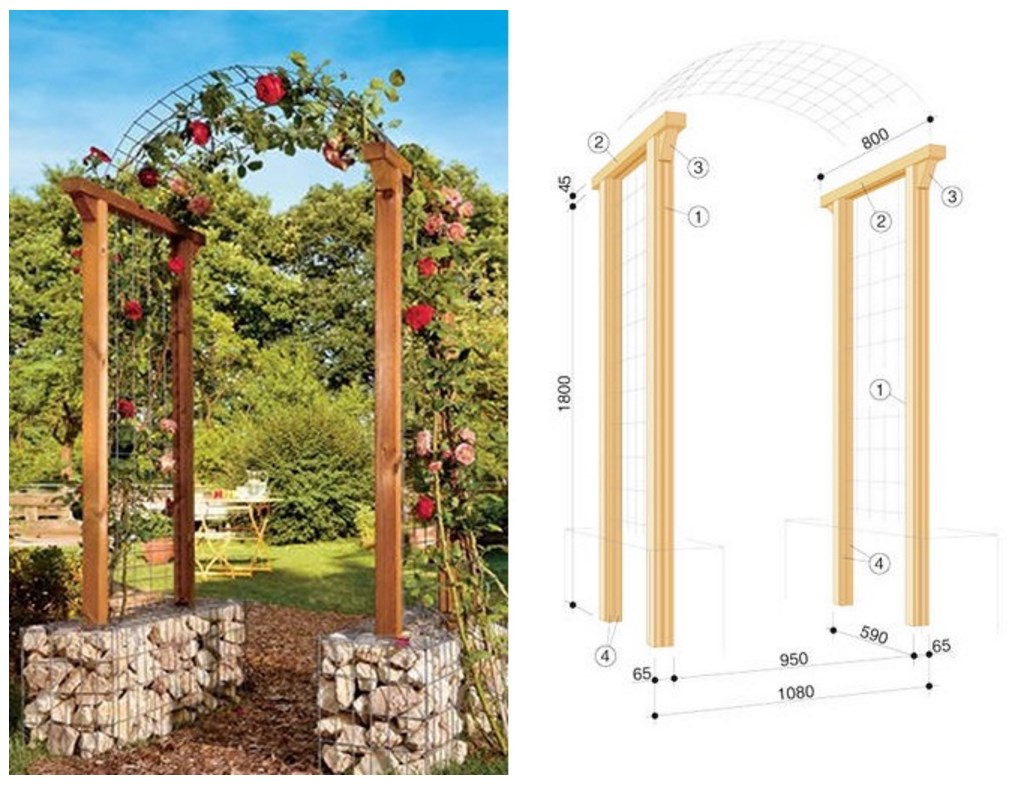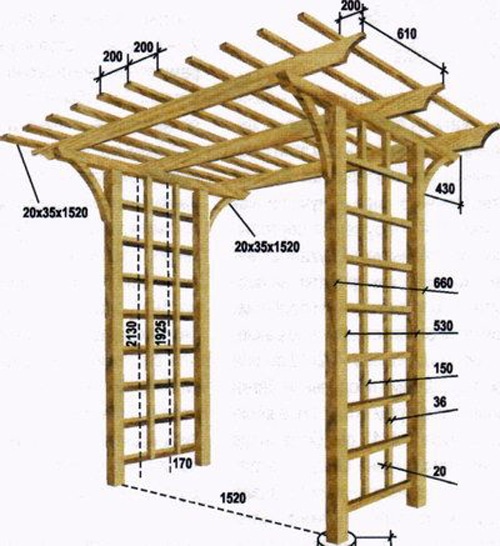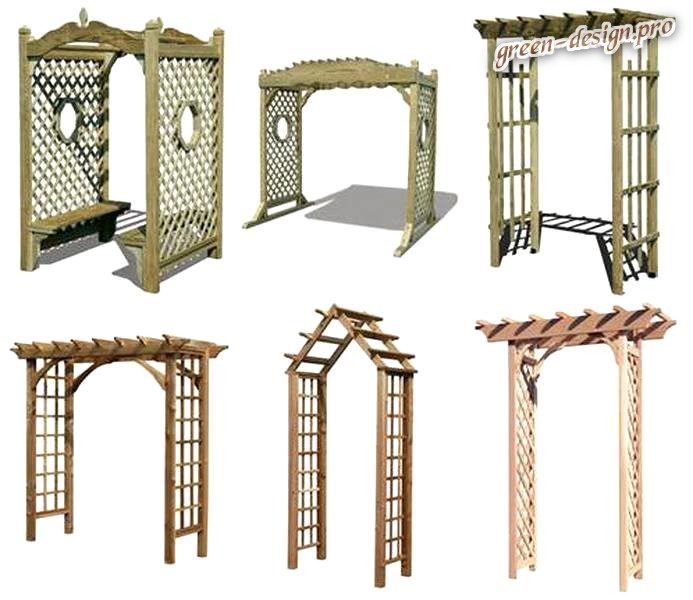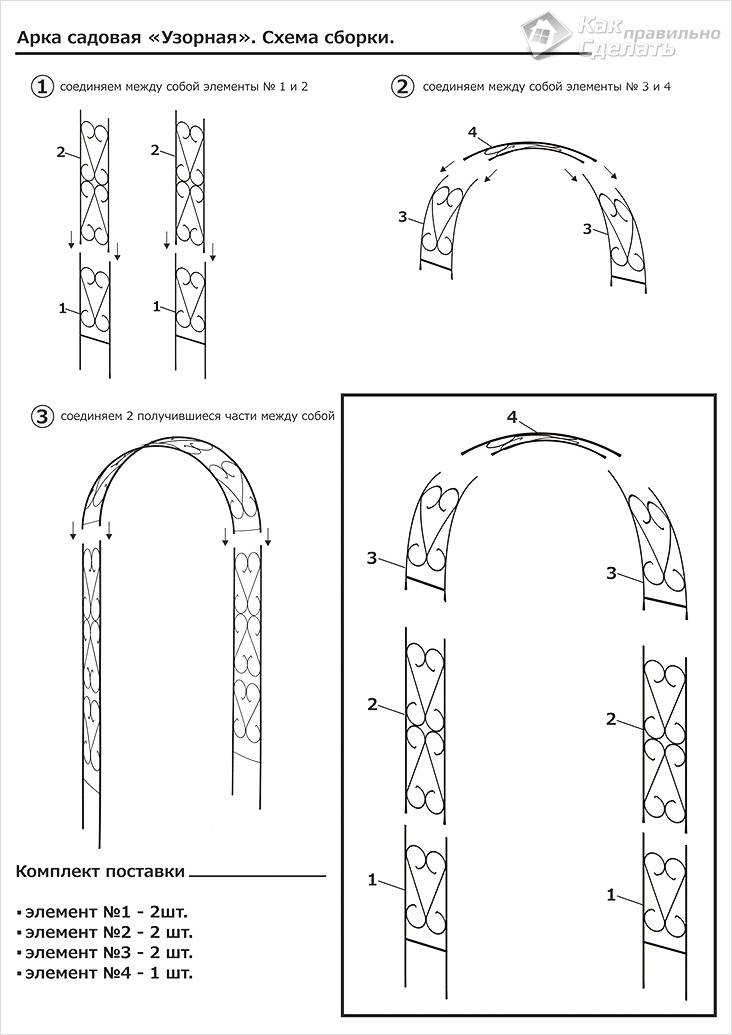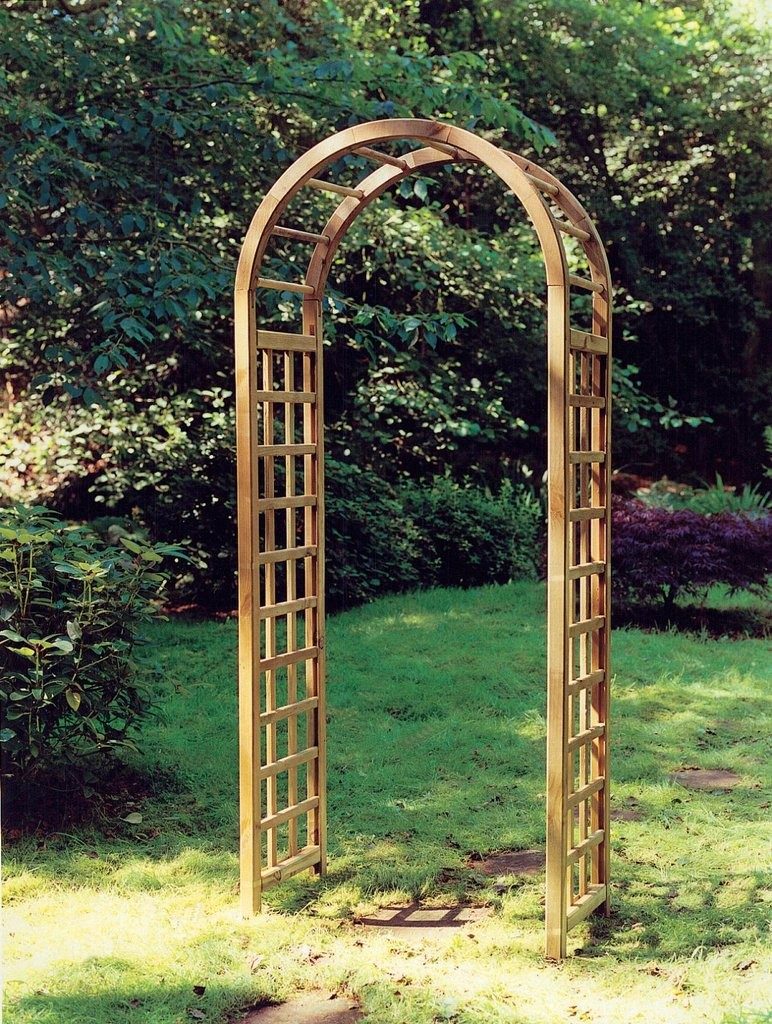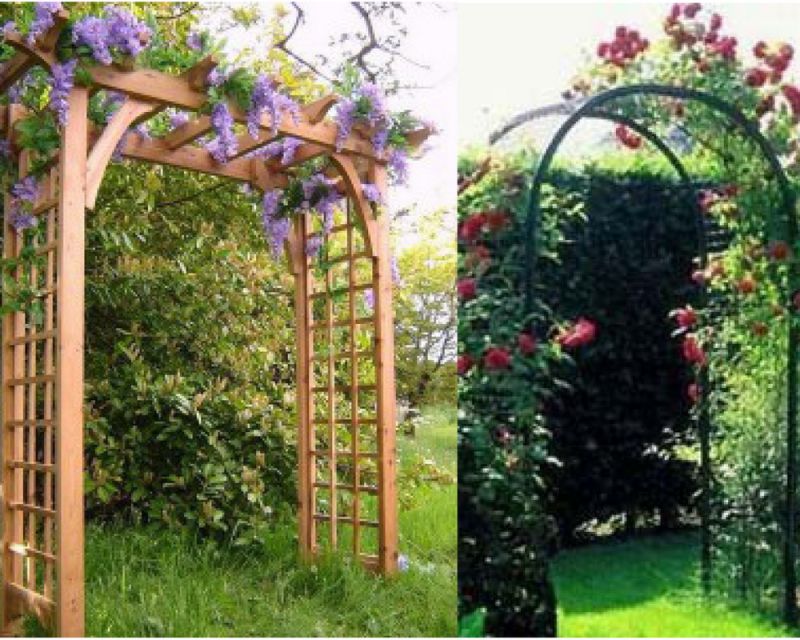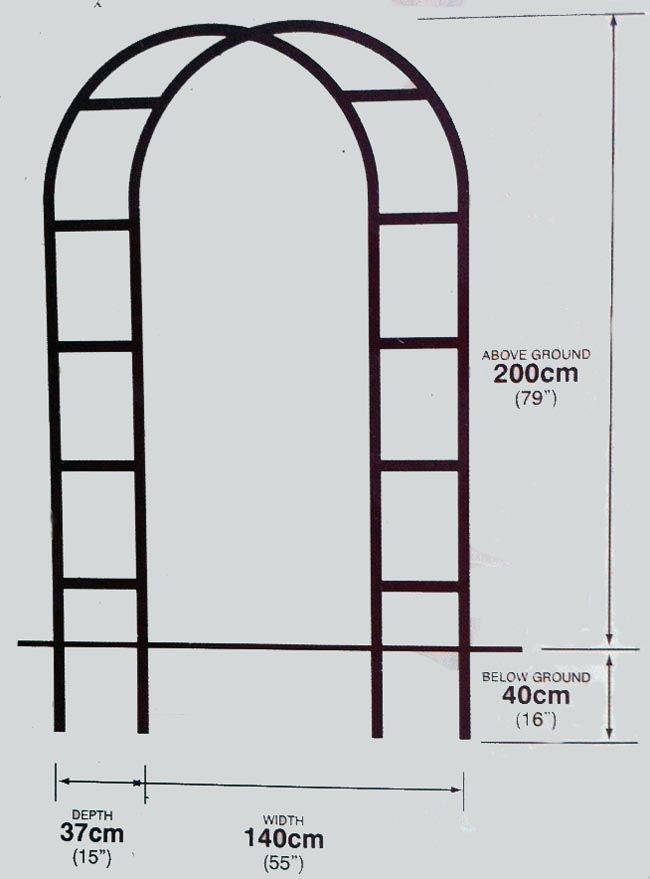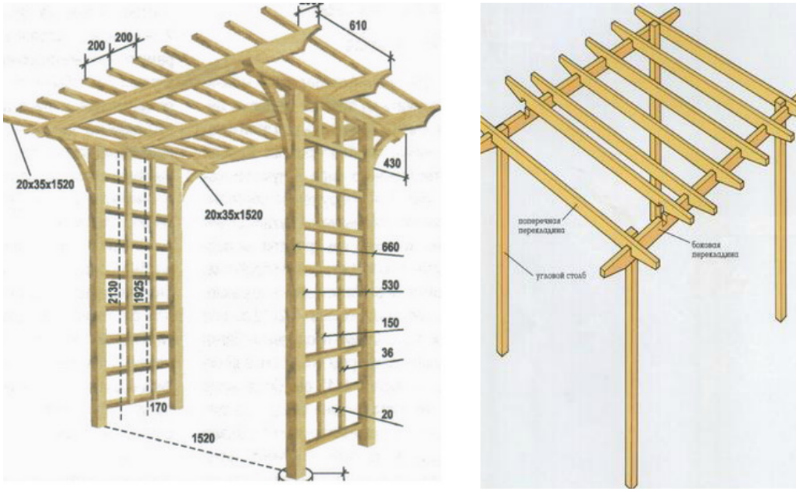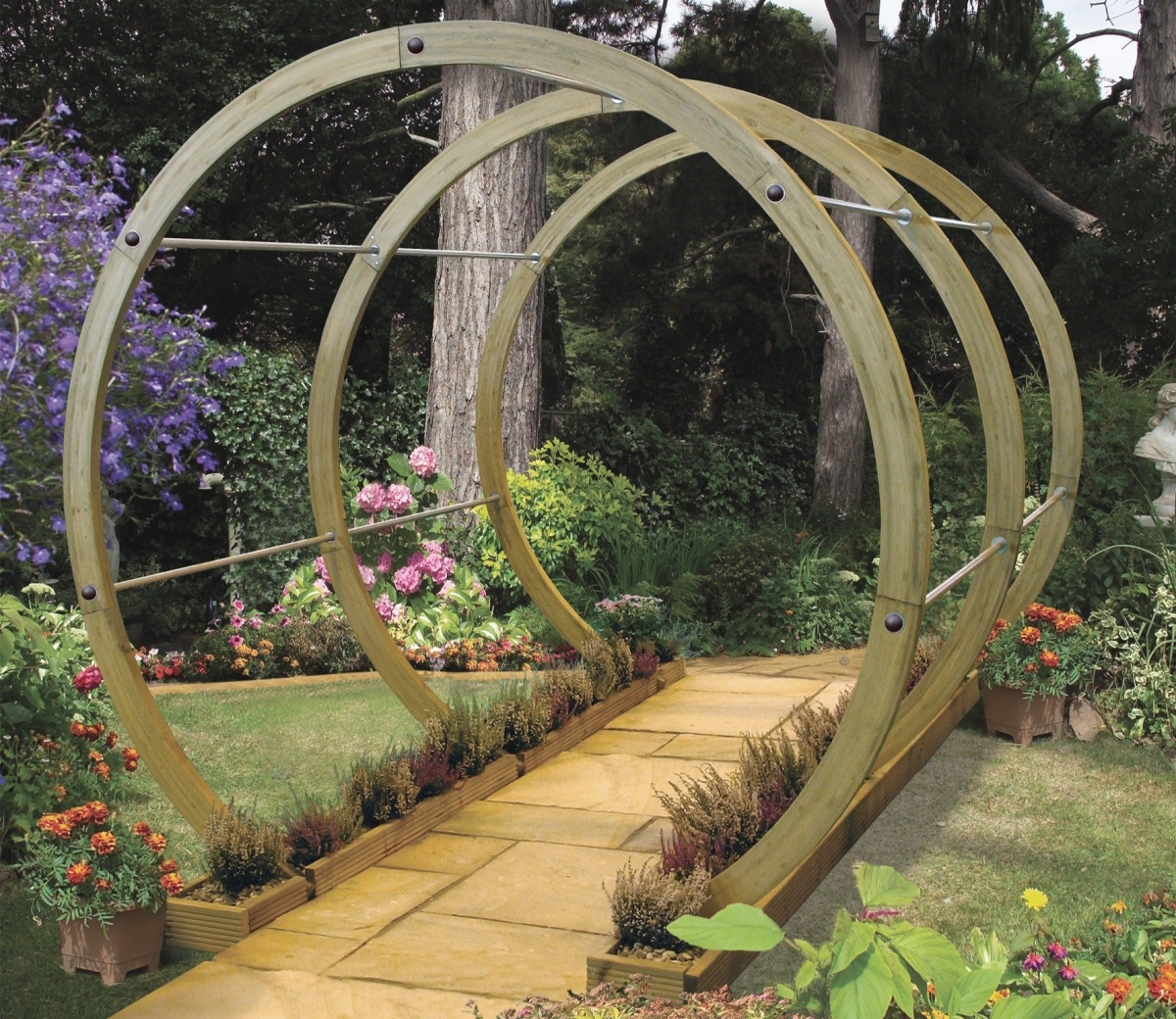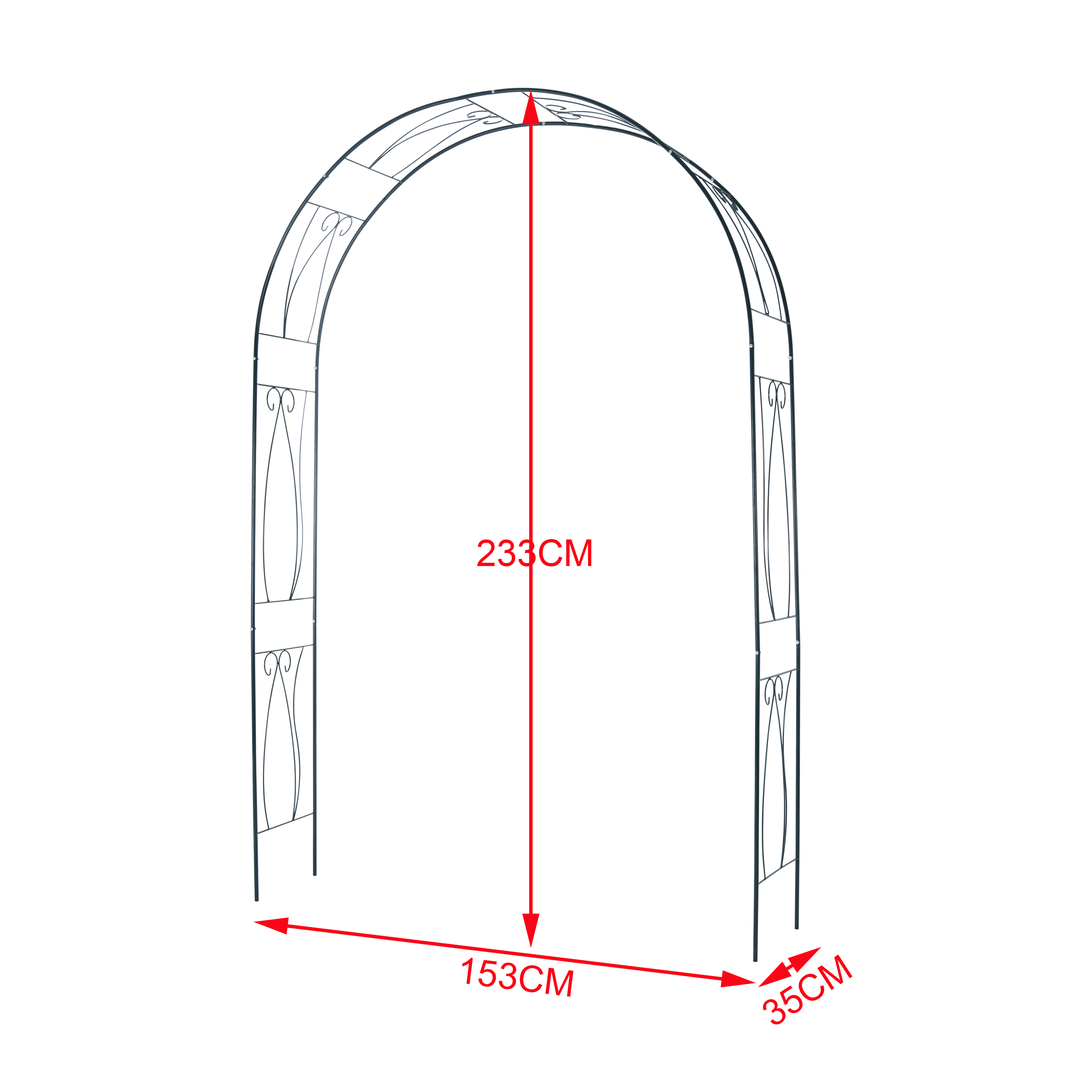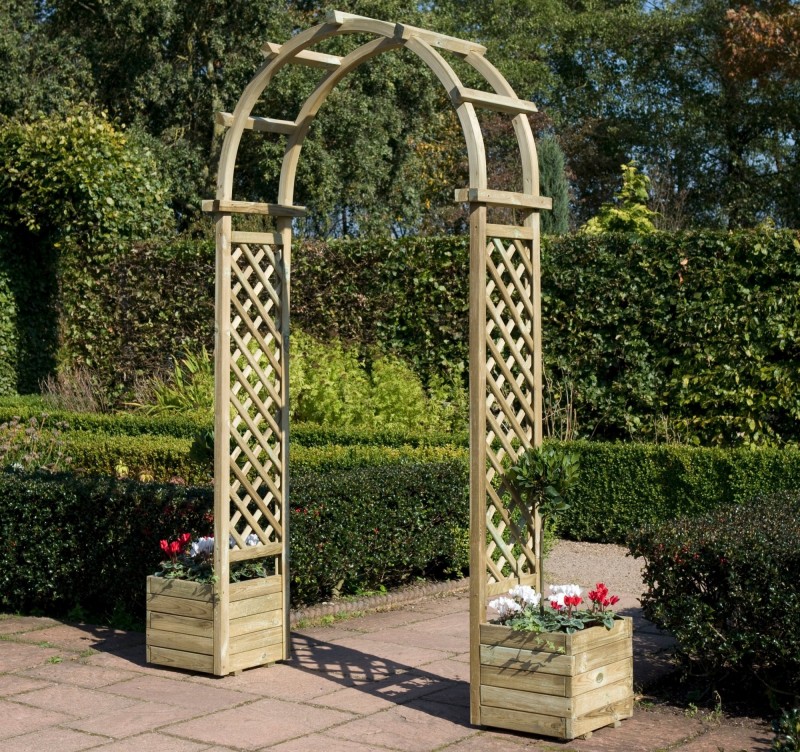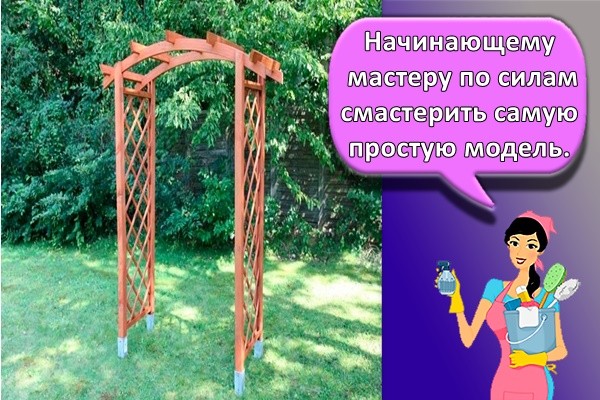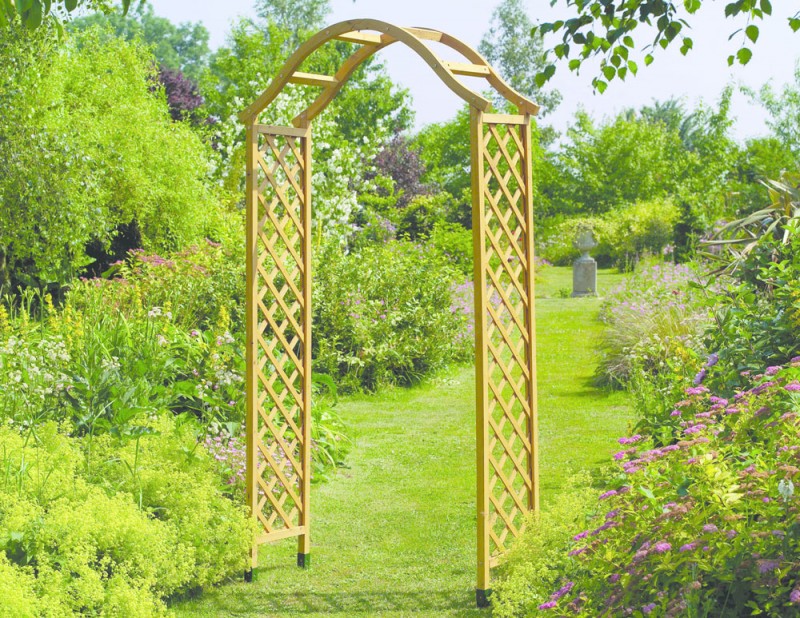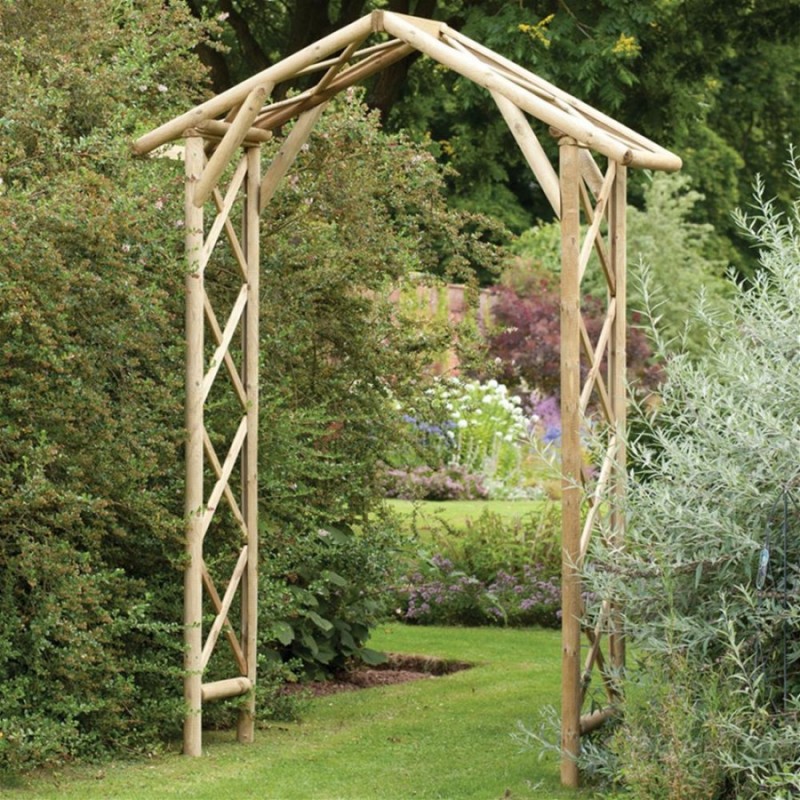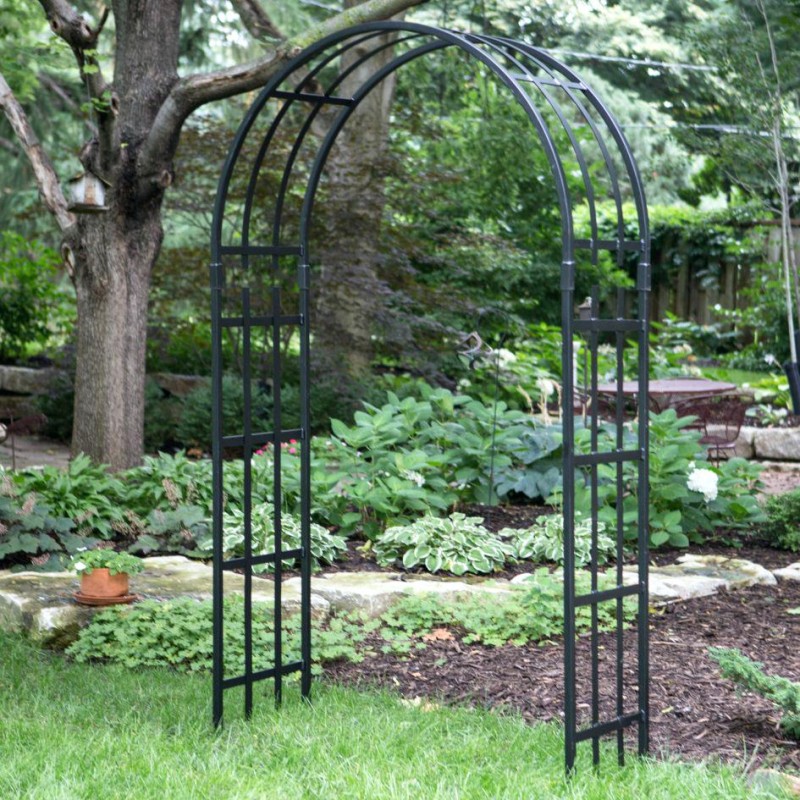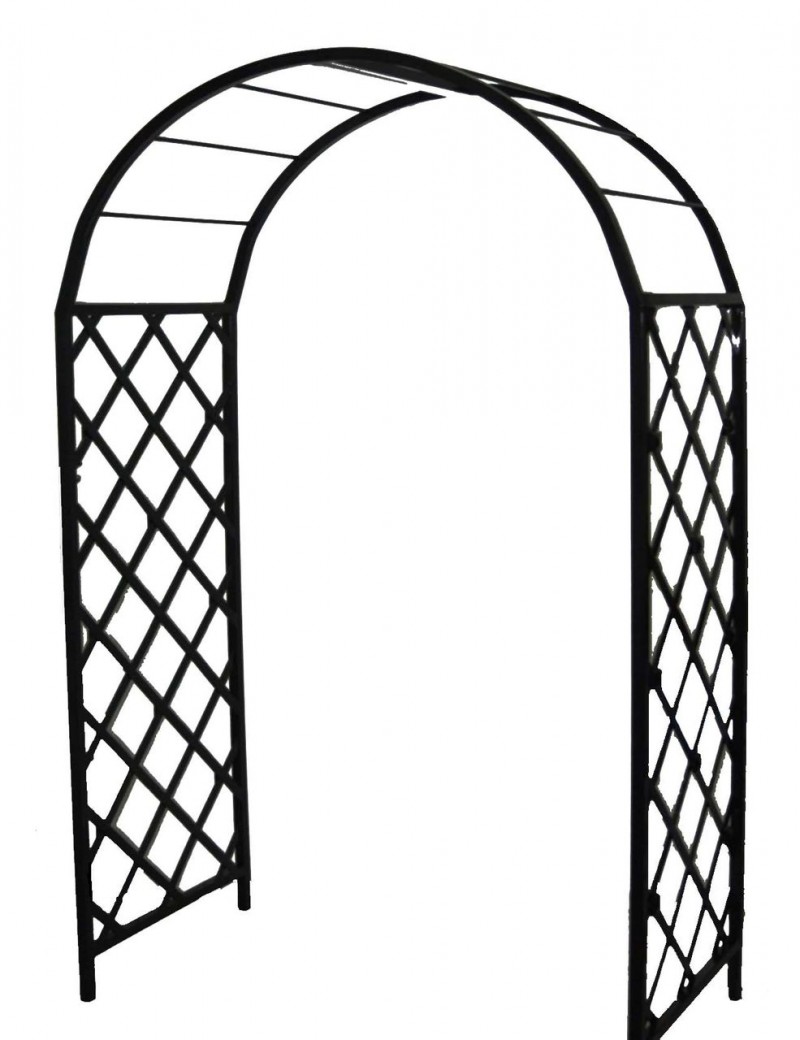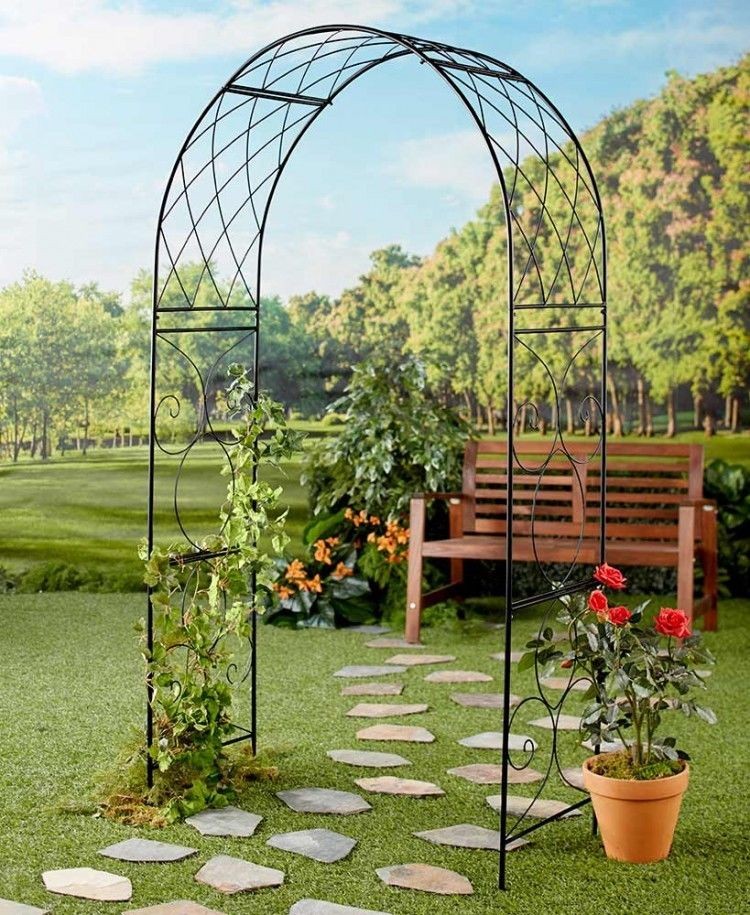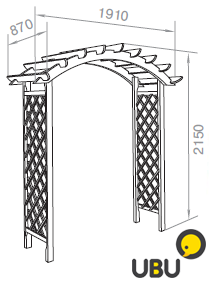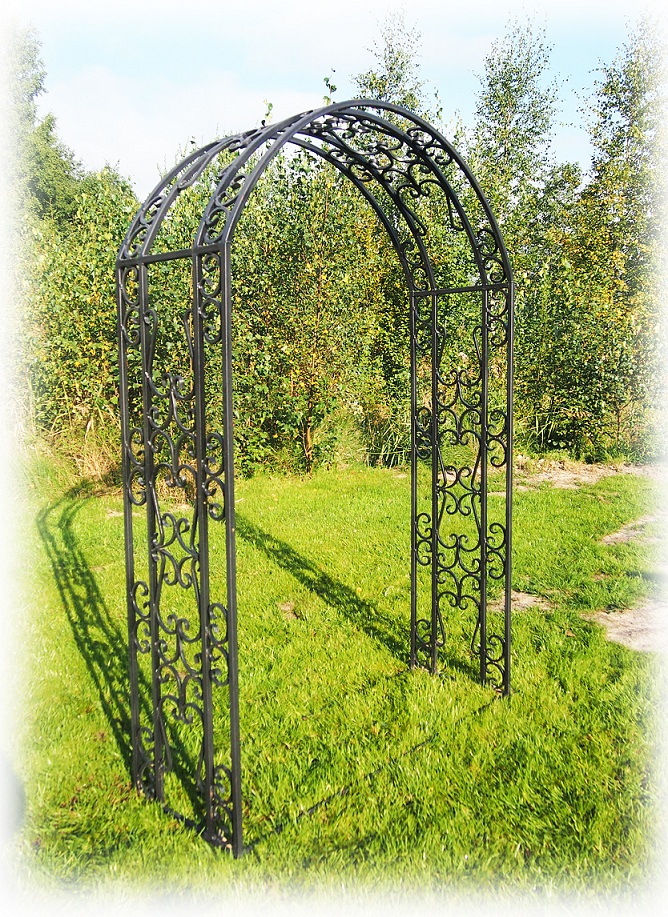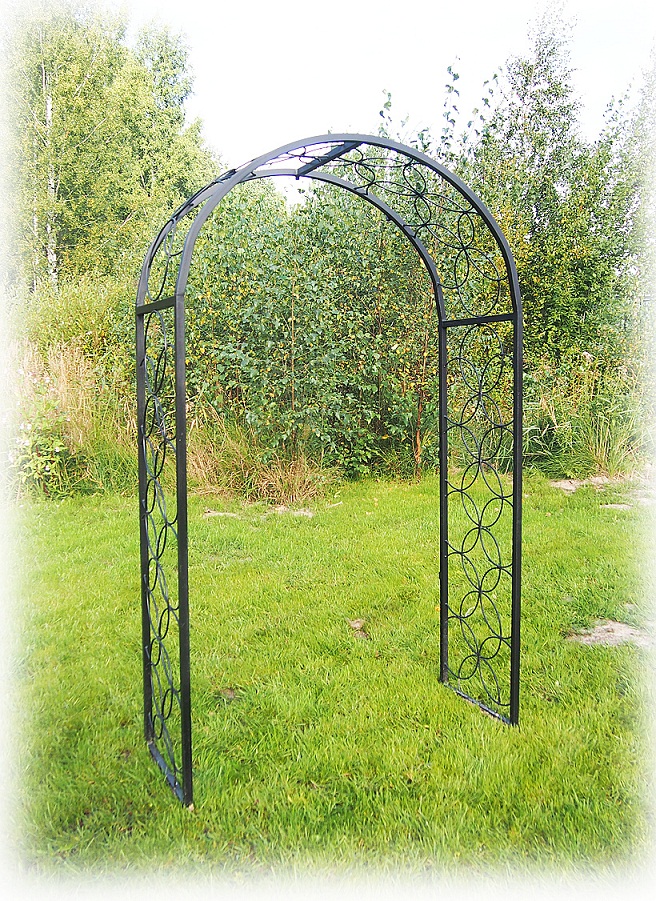Materials and their features
Ornamental garden structures can be built from a variety of materials, modern or traditional. The choice depends on the functions assigned to the element, the general design of the site and the house. Each of the materials has its own merits.
Wooden

The arch made of natural wood is light and beautiful. The wooden model creates a special cozy atmosphere on the site. The material is environmentally friendly, does not harm nature, is available, therefore it is in great demand. In order for the tree to serve for a long time, it must be properly looked after. The material is prone to swelling, decay, therefore, it needs to be treated with an antiseptic, moisture-resistant and fire-fighting compounds. It is not difficult to change the appearance of the arch in the garden, it is enough just to paint it in the color you like or cover it with a stain, giving it a beautiful shade. Structures made of natural wood, covered with a transparent protective varnish, look good.
Plastic

Manufacturers produce hundreds of different models of arches for flowers in the country (you can see the photo). Plastic structures are easy to install, carry and wash. Disadvantages:
- Plastic is highly flammable.
- It is fragile, does not withstand mechanical damage.
- May crack in the cold.
But plastic is inexpensive, so it is not difficult to replace a worn-out product.
You can also assemble a plastic decorative element yourself. To do this, you need to find a sufficient number of strips and pipes, purchase fasteners. Then draw a diagram and assemble an arch.
Important! Install plastic arches no closer than 10 meters from a brazier, barbecue or other source of fire.
Metallic
Metal structures are strong and durable. They can be welded on their own; any thin metal pipe or rod is suitable for manufacturing. Also on sale are ready-made prefabricated and one-piece structures. Maintenance of such structures is not difficult, it is enough just to regularly treat it with anti-rust compounds. The metal construction is versatile. For example, solid wrought-iron arches are suitable for a large garden in a country cottage, and lightweight prefabricated arches are suitable for a summer residence. However, elements welded from thin rods can bend under the flower mass.
Stone structures look solid, impressive, they serve for a very long time. The only thing is that they can grow over with moss, and chips appear on the stones over time. They build monumental structures of dolomite, cobblestones, shell rock, clay bricks. The shape and size of the arch can be any. These structures do not require additional decoration, they already create a special atmosphere on the site.
Stone can be combined with wrought iron flower arches to create an unusual architectural group. But in order to erect a stone structure, you need to have building skills. In their absence, it is better to contact a professional.
How to choose plants
The climatic zone determines the range of climbing plants that can be planted next to the arch. Usually, annuals and perennials are planted near the base of the structure. In the latter, decorative qualities appear in 1-2 years.
Letniki compensate for this shortcoming. Near the arch you can plant nasturtium, sweet peas, kobei, morning glory. While perennials are growing up, garden structures are decorated with hanging pots. Petunias and begonias blooming throughout the summer are planted in them.
The choice of perennial plants for decorating garden arches is huge:
- bougainvillea grows well in the shade, its shoots reach 10 m, and purple, crimson flowers are incredibly beautiful;
- unpretentious hops are suitable for busy summer residents; they do not need regular care;
- Liana Campsis quickly wraps around the support, its yellow flowers, peeking out from behind the leaves, adorn the garden until late autumn;
- an excellent choice is clematis, it is not inferior in beauty to roses, but it needs to be looked after, it needs regular watering and feeding;
- climbing roses are out of competition, the bushes are planted at the base, the shoots, as they grow, are attached to the elements of the garden structure.

The main functions of a garden arch
Correct zoning makes the garden cozy and well-groomed. It is difficult for a non-professional to cope with this. Building a garden arch helps to solve the problem. Twisted with climbing plants, it will decorate the transition from the front area to the utility area, designate the territory of a flower garden, a recreation area, a parking lot, a playground.
Decorativeness
The space for the construction of a decorative arch in the garden will require less than for a gazebo. It is not difficult to organize a cozy resting place under it. Modern garden furniture is light and beautiful, looks great against the background of climbing plants. The arch is often used as a separate decorative element. It is installed on the path that runs along the lawn, or in a cozy corner of the garden. Arched forms look harmoniously against the background of artificial reservoirs, they are built on bridges thrown over a pond, a stream.
Support for flowers, for other plants
When space is scarce, the vertical design replaces the flower bed. Modern designers use the arch as an element of vertical gardening. Climbing plants planted next to it receive an elegant support, and the garden is a wonderful decorative element.
Part of the structural element
Arched structures are made part of hedges, gazebos, terraces. For example, a gate is a visiting card of a country house, garden plot. The arch installed above it acts on one side as a decorative element
The design decorates the appearance of the fence and attracts the attention of passers-by. At the same time, it performs an important function, strengthens the pillars to which the gate is attached
Support for benches or swings
The welded metal structure is a reliable support for the bench. She is graceful, stable. It can be transferred from one corner of the garden to another, using it as a support for climbing summer plants, perennials.

An excellent place to relax is a wooden arch over a bench, a swing, entwined with maiden grapes, roses or clematis. It's good there in any weather. It is cool in the heat, dry in the rain.
Instructions on how to make a garden arch
The simplest structure can be built from metal-plastic pipes used for plumbing in apartments.
You need to prepare two identical pipe sections. Their length is the sum of the height of the arch, multiplied by 2, plus 1 m for the bend, plus 1 m for digging into the ground (50 cm from both ends).
The most difficult thing is to bend the pipes equally and insert their ends into the previously prepared holes in the ground. They can be drilled with a drill, which is used by fishermen in winter.
Then you need to pour concrete into the holes and fix them until it hardens. When the two arches are securely fixed, you can decorate them with climbing plants.
Arch in the garden: materials and characteristics

It depends on the appearance, dimensions, as well as load-bearing materials, how harmoniously and naturally the arch will fit into the garden. Outwardly, these can be the most unusual solutions from the simplest rectangular shape to an elegant openwork design.
But in order for them to harmoniously fit into the style of the palisade, it is necessary to build them of the appropriate size. There are no special rules on this matter, nevertheless, in landscape design, when decorating a plot of an average area, an arch is used with a width of 1500 mm, a height of 2500-3300 mm and a depth of 500-700 mm (depending on the varieties of the chosen plants for decoration).
Usually, plastic, brick, metal and wood are used for the manufacture of arched structures.
Plastic
The easiest way is to buy and install a PVC arch on the site.But, even in spite of the economy and a variety of colors and shapes, it will be able to serve for a relatively short time, and the level of its stability allows much to be desired.

Such arches are used only as decorative elements, for decoration and zoning, they are not suitable as supports for benches or pergolas for recreation. In addition, they have to be removed for the winter, since in severe frosts, plastic can burst, and the problem is that they cannot be placed in the immediate vicinity of a barbecue or an outdoor stove.
Brick and stone
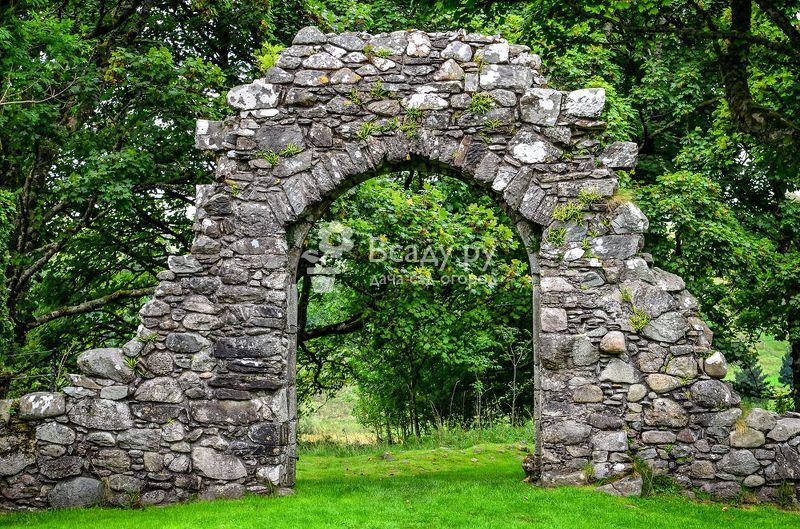
These materials are the most durable. Of course, anyone can make a rectangular arch from brick using drawings and facing bricks, but really unusual specimens that can be called an architectural miracle can only be a true professional in their field.
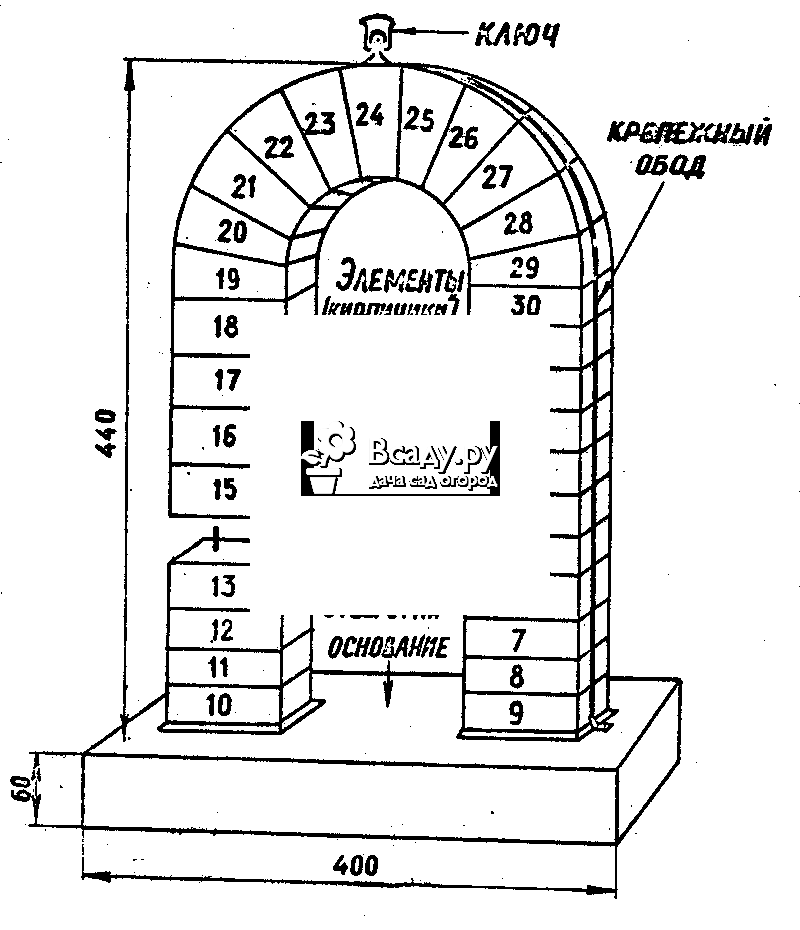
Brick arches can be so original in themselves that to emphasize their beauty, you do not need a frame of plants and flowers. For example, a stone vault above an entrance gate or a central walkway looks very impressive. Also, such an element of decor is ideal to highlight a garden pond or flower bed.
Wood
The best way to make an arch to the garden with your own hands. An arch made of natural wood is easiest to fit into any style. You can also choose a garden set for it, or create a whole ensemble of gazebos, trellises and fences.
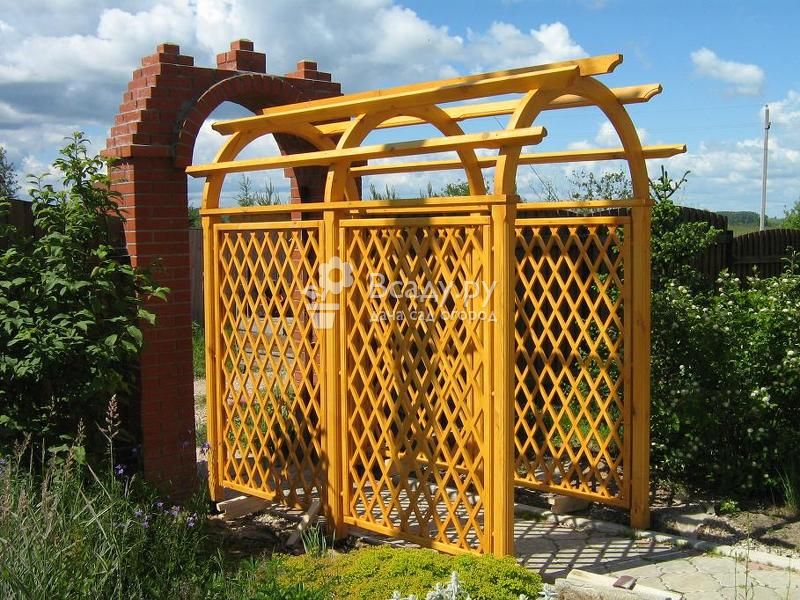
The service life of this material is not very long, therefore, before decorating and installing, the wood must be treated with Stigma-D or Zobel antiseptic agent and covered with a special paint such as MGF Eco Fassade M690.
Metal
The steel arch for the garden is the most durable and reliable. It allows you to create extraordinary planting compositions that will delight the eye both in summer and in winter. The easiest option is to fix the steel wire bent into an arc between the supports.
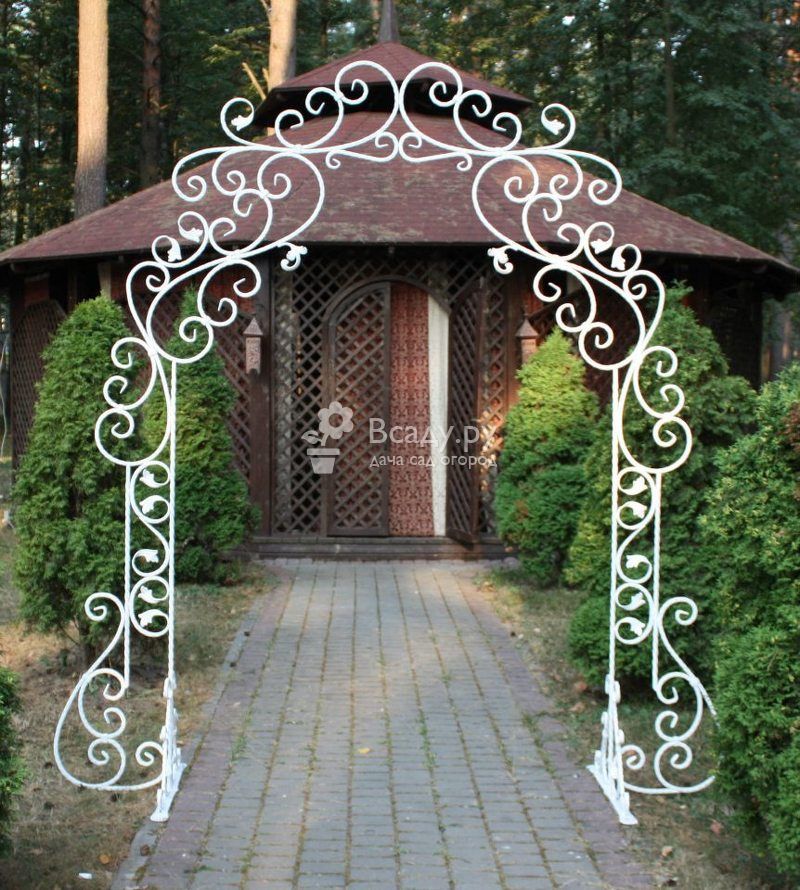
The modern design of metal arches surprises with its diversity, it can be graceful patterned structures or massive structures with wood or stone inserts. And so that the structures do not corrode, their surfaces should be regularly looked after, primed with a special Biotex Effect compound and painted, at least in two layers, with alkyd enamel, for example, Tikkurila Miranol.
The main advantage of metal is decorativeness. You can forge it yourself if you have specialized equipment or order real masterpieces with chrome rose petals from blacksmithing masters.
Homemade metal arch
You will need:
- Two rods of reinforcement 6 m long and 1 cm in diameter.
- Nine rods of reinforcement 94 cm long and 0.5-0.7 cm in diameter.
- Ten pins 25 cm long.
- Soft yet durable wire.
- Rope 1 m long.
- Metal paint.
- Primer.
How to do:
Directly on the ground, it is necessary to draw a template for the future structure, using pins for this. They need to be stuck into the ground with an arc, what the future arch will look like, making the presumptive structure more than two meters high. For convenience, you can draw a neat line in the ground from one pin to another to see a complete picture.
Bend each of the two six-meter rods of the reinforcement along the finished contour so that they take the shape of an elongated semicircle, or, if I may say so, a semi-oval. It is better to resort to the help of another person, because it is physically difficult to do it yourself
It is important to protect yourself from rods that can accidentally slip out of your hands: use a special mask and gloves, work in a durable jacket and pants.
The finished base must be driven into the ground 40-50 cm so that it holds well. It is better to mark the limit on the rods themselves with paint, tape or electrical tape
The distance between the two rods should remain approximately 31-32 cm. The bases of the frame will be connected with special rings, which are described below.
For the rings, you will need rods 94 cm long and about 5-7 mm thick. Each of the nine rods is prepared as follows: using a pipe bender, you need to bend each rod into a ring, the ends of which will fit snugly against each other. If there is no pipe bender, you will have to perform the same maneuver with the pins on the ground, placing the pins in a circle with a diameter of 30 cm.And you can also not complicate your life and connect the base of the arch not in circles, but with horizontal rods, cutting them into shorter parts: 35 each −40 cm.
The next stage is connection. To do this, measure 60 cm from the ground on both sides - at this mark the ring will be attached. Each next one is attached 15-20 cm from the previous one, the fifth ring is located in the center of the structure - at the top. So that the rings are at the same distance, it is worth measuring the length of the rod from the first to the fifth ring, dividing it by four and making marks.
The ring is attached as follows: you need to use a wire to tie the ring to the base at the previously made mark. It is necessary to work with gloves and to tighten the wire well, otherwise the structure may fall apart. To connect, you will need another person who will hold the structure during the connection process.
When the work is completed, you need to cover the product with a primer and leave to dry. After a day, paint is applied, which also needs drying. The arch is then ready for use. You can plant curly flowers nearby or set up pots with such flowers.
If you make a wider acre, using more rings and twigs for the base, it can support the grapes.
It is best to work on warm sunny days and make sure there is no rain, as it can harm the invention of the arch.
Do-it-yourself arch for climbing plants. Garden arch - DIY tips and instructions for building (120 photo ideas)
An arch is a decorative and functional architectural element. People have been creating arches since the times of Ancient Mesopotamia and Ancient Rome. Garden arches are used to support climbing plants, to create shade, and they decorate parks and recreation areas with arches.

In this article, we bring to your attention a photo of garden arches for every taste, we will tell you what materials are used for arches and how easy it is to make a garden arch with your own hands.

The significance of the arch in the landscape
The arch will decorate any space. Graceful and light or solid stone arch - any will become a special element of the landscape that attracts the eye. She will add mystery to the garden, help to arrange a cozy recreation area, divide the different parts of the green space of the suburban area.

Several arches can be located one to another, in one row, or create a shaded gallery. The arches create a wonderful impression over the entrance to the site, as if inviting you to enter the mysterious magical world of nature. In the photo, the garden arch creates a sense of magic and celebration.
Amazing in itself, the arch is also used for plants in the garden. It is decorated with wild grapes, climbing roses, bindweed. Other plants suitable for this design are clematis and honeysuckle.
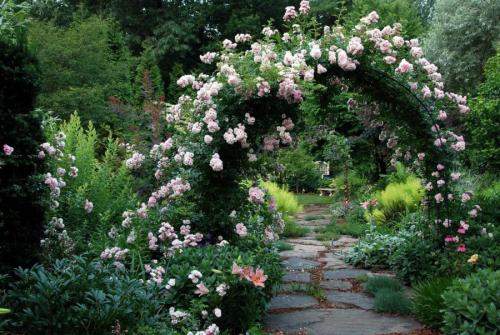
It is possible to decorate the arch with a luminous garland. This decor option will be especially relevant during the winter holidays.

Arch dimensions
The arch to the country house can be of any size. A miniature arch will serve as a decorative element, while a large one will carry the function of a support and is good for creating shade. The arch is possible without decor. To create a northern landscape, wild stone will be a suitable material for the arch.

The simplest design will be a wooden arch, since it can be built on the site from improvised material - branches cut from garden trees.

The eastern subtleties of the landscape with an arch will be added by such plants as adiantium and rhododendron; conifers and shrubs can also be planted nearby.
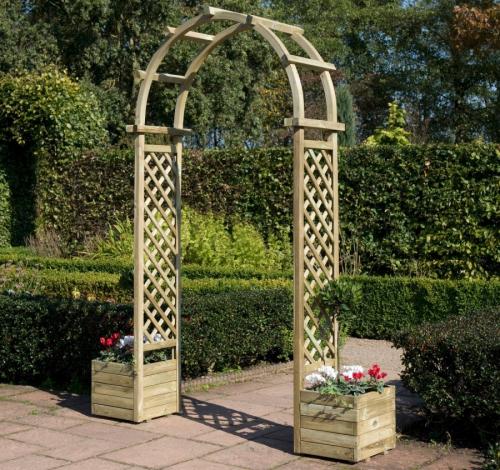
The location of the arch in the garden
These beautiful structures are located anywhere in the garden.They will not only decorate the site, they can also be used to disguise household buildings or technical devices. A metal or wooden lattice arch looks great over a wicket. In this case, pergolas - lattices - create a company for the arch.
Arches are used both to visually increase the space and to break narrow long paths into conventional parts. With the help of this design, gazebos and wonderful courtyards are created.

An arch entwined with greenery located next to the bench will protect from the sun and create a cozy corner for gatherings with neighbors in the fresh air.
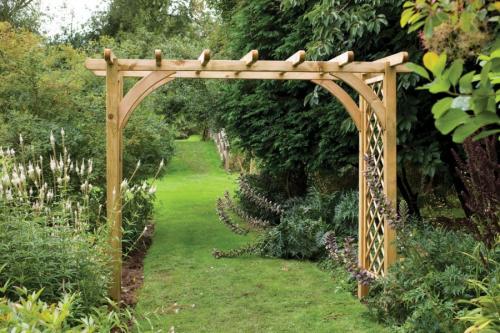
Photos of garden arches will help you choose the right option and not make a mistake in combining materials
The proximity of natural materials, such as wood or stone, with plastic or metal parts may not look very good, so it is important to maintain a sense of proportion and style.

Metal arch
Garden arches made of metal are durable and reliable structures and are easy to create with your own hands. Ready-made purchased metal arches are beautiful, durable and easy to assemble yourself. The disadvantage of such structures is that, being entwined with plants or flowers, arches from a thin bar can tilt.
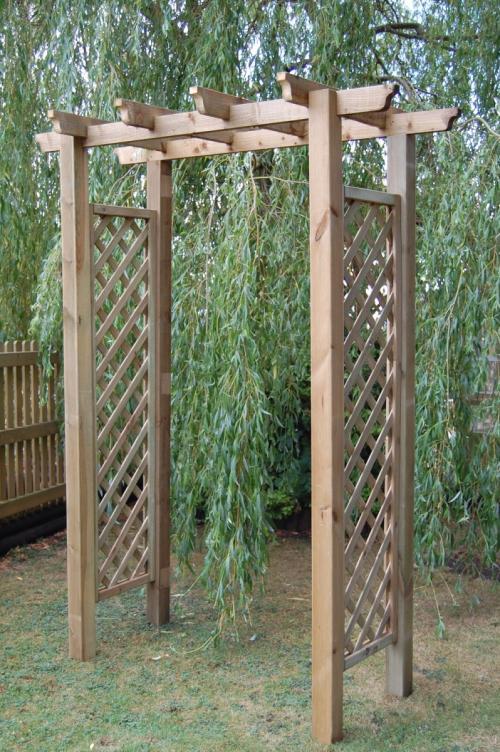
Arch made of wood
Wooden garden arches are inexpensive and affordable, very decorative. They require special surface treatment to create moisture protection.

Do-it-yourself wooden arch
Making a wooden garden arch for a summer cottage is simple. The main thing is to decide on the design. The arch can be square, round and with corners.

The work begins with the preparation of the material and the necessary tools. We make an arch from a bar, the section directly determines the strength of the future structure. The arch can even be made of plywood with a thickness of 1 cm. If desired, a roof is made for the arch at the entrance to the site. The material can be any material, plywood, plastic or boards.

DIY garden arch creation
The construction of a garden arch is a fairly simple job, but, like any other, it requires careful preparation and high-quality execution.

Metal arch
Determination of the dimensions of the structure and the selection of a suitable material
There are no strict restrictions and any standards, other than those described just above (the arch should be about 2 meters high and about 1.2 m wide). The maximum permissible width, which does not violate the overall proportions of the structure, can be about one and a half meters. This will be enough. In terms of height, the taller the structure, the less graceful it becomes. Most often, garden arches are made no more than 3 meters high.
After the dimensions of the structure are determined, you can proceed to the choice of material. So, metal
The garden arch is a durable construction, very easy to install and quite sturdy. But it has one significant drawback - susceptibility to corrosion.
As material for wooden
arches are suitable for both timber and untreated wood. Such structures are less reliable than metal arches.
Plastic
the arch has a very attractive price and is easy to assemble. She is not afraid of corrosion, moisture, deformation. And to model the structure, you only need a soldering iron.

Wooden arch as a garden decoration
Choosing and preparing a place for an arch
Now you should think about where to place the structure, so that it decorates the site and at the same time does not violate the overall integrity of the existing picture. It can be an excellent entrance to the site or to the territory of the house. Try to install the arch above so that it becomes a kind of tunnel on the way from one part of the site to another (a pergola is perfect for this).
Advice. Bulky structures are not suitable for a small garden plot, since they can simply visually reduce the area.The way out in this situation will be a trellis, it will perfectly decorate the territory of the garden and at the same time it can be used as a gazebo by adding a small bench with soft pillows to the arch.
An existing one (for example, a concrete or tiled area) can serve as a foundation for an arch; ordinary soil will not be the worst option. The most important thing is to prepare the foundation for installing the arched structure. The working platform must be carefully cleaned, leveled (if we are talking about an earthen covering), transfer the dimensions of the structure to the site and apply a markup.
DIY plastic pipe garden arch. DIY garden arch: making your site more original
Each owner of suburban real estate wants to make his site special, give it charm and beauty. For this, you can use a variety of decorative and architectural solutions. One of these solutions is a do-it-yourself garden arch.
The arch is a simple structure of two vertical and one horizontal surfaces, which form a kind of portal. The top surface can be either flat or arched. By connecting several garden arches, you can get a kind of corridor - a pergola.
The big advantage of such arches is that in addition to the decorative function, they also have a very specific practical application. So here are the main functions
- decor element (for example, it can serve to divide the site into zones);
- support for all kinds of plants;
- support for a bench or swing;
- the basis for the installation of lighting.
Most often, in a specific area, the arch performs several of the above functions at once. The list of plants that such a model can support is quite extensive. For example, these are roses, grapes, and other climbing plants. Depending on this, the structure must withstand a certain load.
If you plan to use it as a support for non-climbing plants, then it is necessary to provide for the fasteners for the pots in advance.
They can be classified according to several main criteria. First of all, this is the material used. On this basis, arches are:
- ... Metal is perhaps the most durable material. Tubes, fittings, wire can all be used to create garden arches. However, the creation of such a model will require skills in working with a welding machine, and a forged arch to the garden can only be made by a real master for a solid price.
- Wooden. Wood is a cheap, affordable, environmentally friendly material, and therefore popular. It can be a great solution for creating an arch. A wooden piece will work well with any style. If desired, wood can be carved. But it was not without its drawbacks - the wood needs constant care, treatment with varnishes and antiseptics, otherwise the structure will not stand for a couple of seasons in proper form.
- Plastic. If the plastic arch is made independently, then plastic pipes are almost always used. The cost price of such a structure is very low, but it turns out to be not very durable and aesthetic.
- Stone. An expensive but reliable option that will last for many years. However, such designs will look out of place in a small area.
- Woven from the vine. The vine, when used correctly, can give a simply stunning result from an aesthetic point of view. However, this will have to work hard. It is best to additionally reinforce the structure, for example, with a metal frame.
Making a wooden arch
Arched structures made of wood do not differ in great strength and durability, but they look great and natural in a natural setting. With proper preparation and installation, a wooden arch can serve for several decades. To work, you will need the following tools and materials:
Arch construction tools.
- hacksaw for wood;
- screwdriver;
- belt grinder;
- building level;
- paint brush;
- stain;
- varnish or paint for wood;
- bayonet shovel;
- timber 100 × 100 mm;
- board 20 × 100 mm;
- cement M400;
- gravel;
- sand.
After all the necessary equipment and material have been prepared, you can start working. Installation is carried out in the following order:
- The marking is carried out on the ground.
- Pits are dug with a depth of 70 to 120 cm. The depth depends on the properties of the soil and the strength of the wind in the area.
- Supports are being prepared. To the depth of immersion, they are coated with grease or bitumen and wrapped in cellophane.
- The supports are lowered into the pit and concreted. Their vertical is checked by the building level. The supports can be corrected within 1 hour after pouring the solution.
- If a pergola is being built, then the supports are connected with transverse slats. They will strengthen the structure and serve as additional support for climbing plants.
- The top of the arch is being assembled. Carrying fragments are placed first. Then they are connected by slats. For a tighter coverage, you can stretch fishing line, aluminum wire or twine between the supports.
Brick arch masonry scheme.
One nuance should be taken into account. Before attaching the fragment to the arch under construction, it must be processed.
The wood must be treated with an antiseptic, varnish and stain. After installing the part on the frame, it will be impossible to get to the slots and joints.
Fasteners should be selected that are resistant to corrosion. Better to choose aluminum or copper screws.
A reasonable solution would be to make the wooden structures collapsible. For the winter, they can be dismantled, serviced and repaired. Store the components in a dry and heated room.
With your own hands
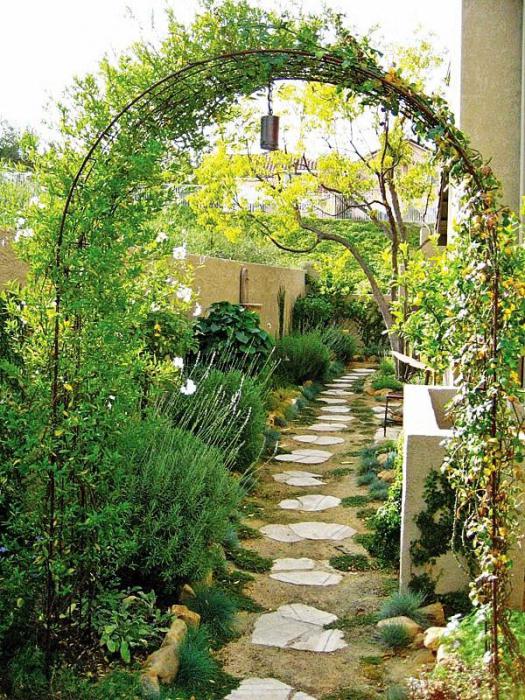
Photos of these amazing compositions, pleasing to the eye, can be seen in many prestigious magazines. But one should not think that a blooming pergola or a trellis structure is the lot of the elite. You can, of course, buy an arch for your garden or summer cottage in the store, but if you wish, you can easily build it yourself. And, it should be noted that often a self-assembled structure looks no worse than the purchased one. The main thing is to know
At the dacha for flowers, many use the simplest building materials that are at hand. These can be metal pipes, wooden posts or beams.
It is always more pleasant to create beauty on your own site on your own. The arch can be placed both along the path and in the corner, separating it with a recreation area.
We mount a wooden arch
The wooden arch is very easy to install. To do this, we need: a wooden beam about 4 cm thick (at least), glued wood about 10 cm, nails, gravel, glue.
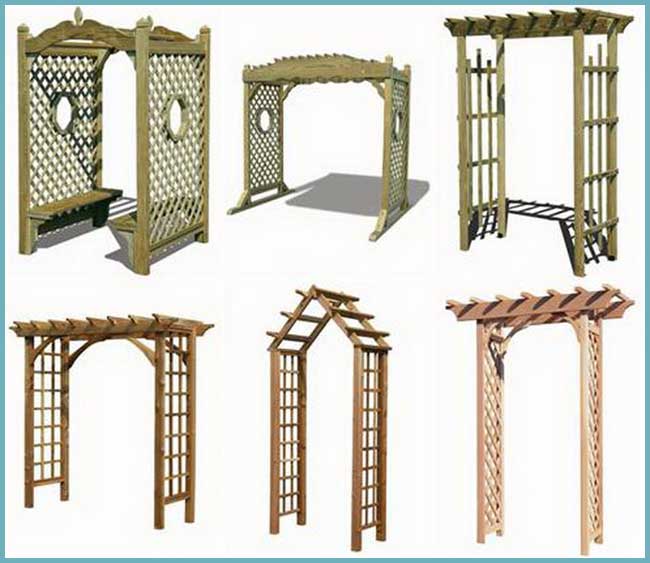
Forms of arches for plants
Schematically, the order of work is as follows:
- We dig in the stand-up beams into a pre-selected and prepared place.
- Crushed stone is poured into the base of the wooden posts, and the wood remaining above the surface of the soil should preferably be treated with resin or burned.
- We fasten the upper parts of the racks with a crossbar in the shape of the letter P, connect the sides with jumpers like ladders using screws.
- On top of the resulting structure, we mount an arcuate crossbar, which we fasten in the same way as the previous one.
- We cover the finished structure with a primer and paint with a special compound for wooden surfaces.
- The final touch remains - we decorate the arch with plants, flowers, etc.
Places to install the arch
It does not matter where the arch will be installed, near a house, a gate or somewhere on the territory, it will always be a spectacular element of decor. By placing an arch, you can think over the entire further design of the site.


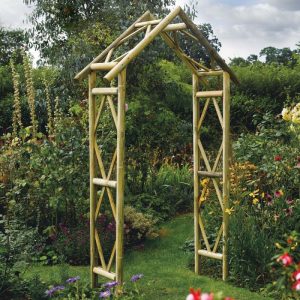
The garden arch looks great, placed on the path that runs through the lawn. It can be done in subtle shades or vibrant colors that contrast with the surrounding elements.

The swing can be equipped under an arch entwined with greenery.In this case, you will be able to enjoy relaxing in the shade of plants even on the hottest day. You can place several arches along the path or make only one for the entire area.
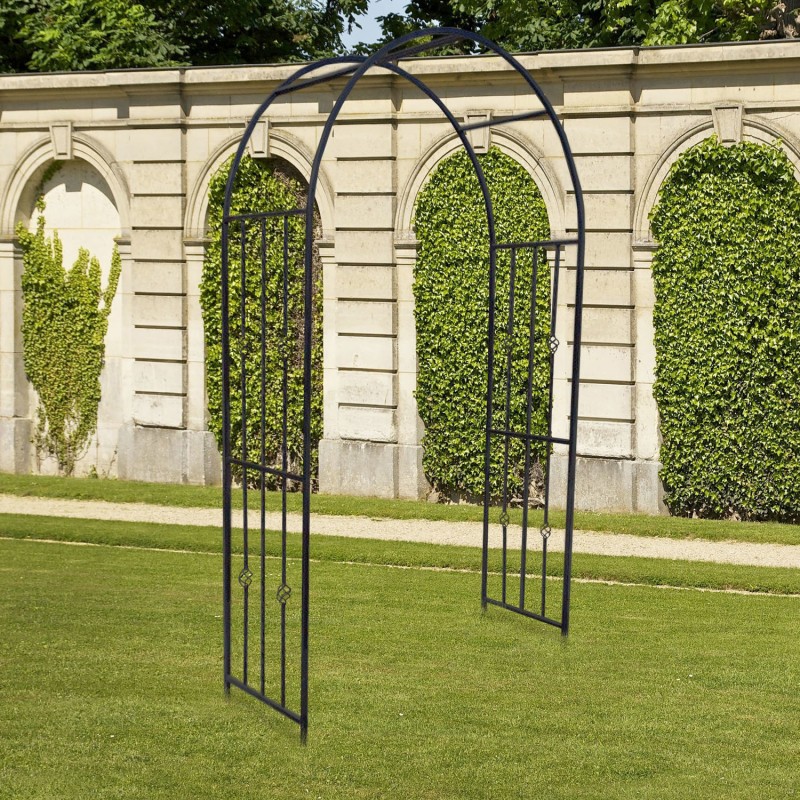
The stone arch will help to recreate the atmosphere of the Middle Ages.
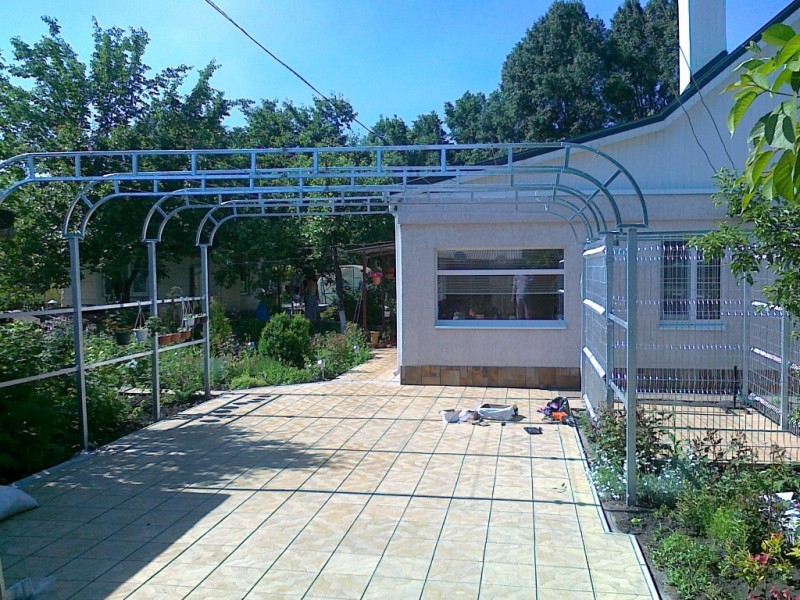
The most traditional option is to place an arch near the gate.

Features, functions and types of garden arches
Most often, these arches consist of 2 parallel posts (as a rule, they are simply dug in, without pouring the foundation), and on top either a transverse beam or a semicircular one. There is no strong load on them, only floral vegetation, so it is not necessary to strongly strengthen them somehow.
Here are some of the features when building them:
- It must be functionally capable of supporting vegetation.
- In height - from 2 meters and above, so that even a tall person can easily walk under them.
- In width - from 1.2 meters, keep in mind that when plants grow, they will hide a little volume from the inside, and then, narrow hikes will visually reduce the size of the space, and narrow arches will look neglected.
- Take care of creating a cultural arch. After all, even a bare frame looked aesthetically pleasing, because in winter it will stand without any decorations, but it should still please the eye.
- The type of construction should correspond to the general design of the site.
Criteria for the classification of arched structures:
- According to the material from which they are made - metal, plastic, wood, stone, combined.
- By the type of frames - arches, trellises - vertical lattices, pergolas - elements fastened together, creating a volumetric structure, the rest are complex structures.
- According to their location on the ground, there are several arches, a wall of trellises, an insulated structure, including one in the form of a gazebo.
Also, arches can fit in by performing a few more functions:
- Maintains a consistent architectural style.
- It is a good support for plants.
- Successfully zoning a summer cottage.
- Supports load-bearing posts.
- Serves as an excellent base for children's swing.
- Fits under lampposts and serves as a seating area.
We make our own arches
The work is generally simple, but it takes time to prepare and the assembly itself with installation.
If you read this article, you can make a garden arch in the future. First, we decide on the material and dimensions. As for the size - the higher the arch, the more elegant it looks, they can be 3 meters each. The average width is one and a half meters. There are no rigid standards on this matter. With the dimensions everything is clear, it remains to pick up the material.
So metal. Your arch will be strong and durable, easy to install. But it is necessary to additionally cover it with anti-rust, otherwise it will soon lose its elegant appearance due to corrosion.
Plastic - such an arch is cheap and easy to install. Not afraid of moisture, deformation, corrosion. From the tools at hand, a soldering iron is required during installation.
Wood - both timber and wood without processing are suitable. In terms of reliability, it is inferior to metal ones.
Choosing and preparing a place for the installation of arches
If you want a garden arch to appear on your site, which you can make with your own hands, then step-by-step instructions will help you in this matter. Now we figure out the best place to install such beauty. It can be located at the entrance to the site, or at the entrance to the house.
Do not install large and bulky complexes in a small area, they will visually conceal the already small space around them. A trellis with a bench leaning against it with soft cushions as a seating area would be appropriate here.
We prepare the working site in this way - we remove the debris, level it, mark it for the dimensions of the future structure. Both a tiled area and ordinary holes in the ground will come down as a basis for it.


